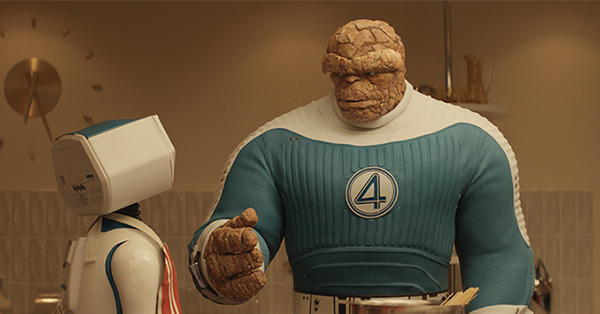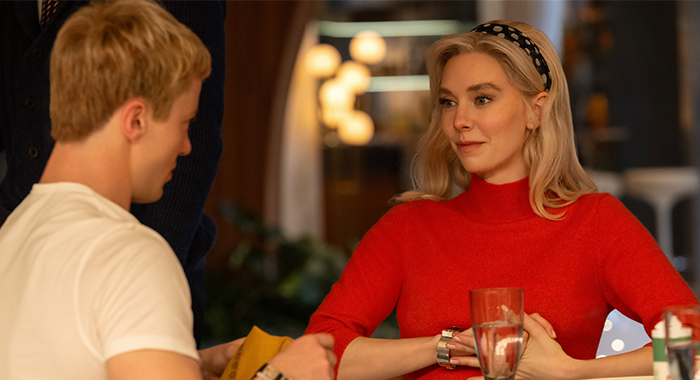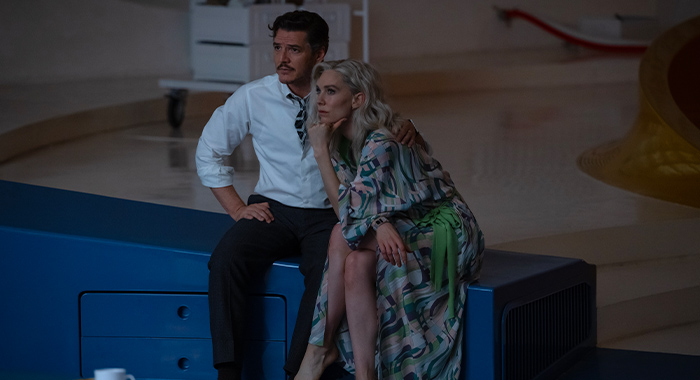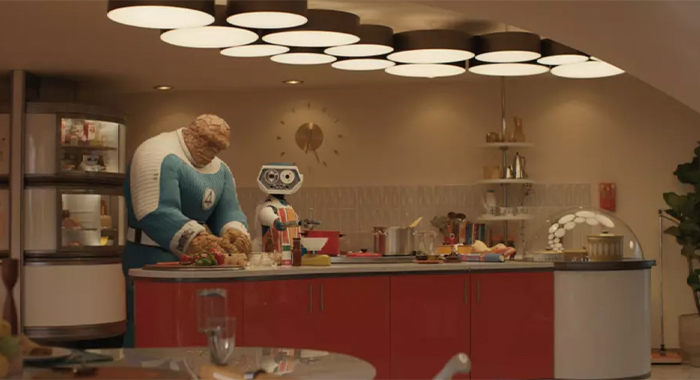It is September 2024 and although the location is Pinewood Studios in the UK, Rotten Tomatoes finds itself — along with a few other journalists — in another reality. Although the precise designation for that universe is currently unknown, we can tell you one of its features is the Baxter Building. Of course, aficionados of Marvel history will know that structure as the home of the Fantastic Four.
Their apartment is a glorious two-story contemporary dwelling. Or at least, as contemporary as the setting of Marvel Studio’s The Fantastic Four: First Steps. As various trailers and teaser images have made clear, the July release is set in a 1960s both familiar and different from our own. The colors and aesthetics of the team’s home evoke a memory of the era, when all seemed possible and folks across all social strata aimed to feature new styles and new colors in their newly constructed homes. Standing inside the set and sitting in the kitchen, as seen in the more recent trailers, really offers a sense of the era’s optimism and the positive attitude Marvel has for the film.

As director Matt Shakman later told us, “The comics were created in the sixties and they’re very much informed by the space race and that JFK sense of optimism, and it really defined that decade, right, looking to the stars.”
Debuting in 1961, The Fantastic Four was the first team book created and designed by artist Jack Kirby and writer Stan Lee. As the latter would mythologize in subsequent decades, the company (then known as Atlas Comics) was in trouble and Lee, also an editor, was gearing up to quit, but was encouraged by his wife to write some stories about characters he believed in. Enter Reed Richards and Sue Storm, her brother, Johnny, and Reed’s best friend, Ben Grimm. Stealing away in an experimental rocketship, the four return to Earth with strange powers. Kirby, meanwhile, introduced a wild new idea on nearly every page. The title was a hit and began what some call the Marvel Age of Comics. Atlas even changed its name to Marvel to reflect the new sense of wonder and optimism Kirby and Lee infused into the business.
“You see it not just in The Fantastic Four, but you see it in Star Trek, which is another project all about family and about optimism and about believing that the right head and the right heart in combination can solve any problem,” Shakman continued. “You see it in Spock and Kirk, you see it in Sue and Reed, and so these are some of the similar thematics that we’re dealing with, not trying to subvert the space race at all. I actually love that idea of dreaming and looking at the stars.”

But as the sense of place is so meaningful, production designer Kasra Farhani, a veteran of Marvel’s Loki, let us know where in New York the building sits even as the characters look to the stars. “[It is] somewhere on the east side of Midtown Manhattan,” he explained. Gesturing toward the balcony just off the living room, he indicated its large windows face west. “Just over there is the Chrysler building,” he continued. “Just over there is the Empire State and straight ahead is Times Square.”
The sightline does have one curious detail, though: a launch pad indicating just how different the Four’s 1960s Earth is from our own or even the one detailed in most of Marvel’s productions until now.
Back inside the apartment, Farhani pointed out some of the womb chairs and other vintage pieces adorning the abode. He was quick to point out where he and his team had to design and construct certain elements — like a central fireplace — but even those pieces underscore the overall feel of the space. “Despite being set in New York, this sort of quintessential, whimsical version of mid-century modernism is sort of more of a west coast American version,” he said. Nevertheless, it is all contained inside a New York skyscraper.
Like other elements in the film, such as the Fantasticar that debuted at last year’s San Diego Comic Con and the droid H.E.R.B.I.E. glimpsed in the trailers, the apartment set is practical with CGI only augmenting some aspects. Star Pedro Pascal admitted he was relieved. “Pretending something is there that isn’t gets harder and harder as you get older,” he said. “And having it there it’s just everything, just playing and you’re believing it because it’s all in front of you.”

Of course, all of this effort to both recreate an era audiences recognize and draw attention to the differences in what can only be called an idealized, retrofuturist reality is in service of presenting, for the first time, the Fantastic Four in a Marvel Studios context. Although the characters have appeared in four films prior to First Steps, including one produced by Roger Corman that was never officially released, they have never been this close to the Marvel Cinematic Universe before.
Shakman, who also directed Marvel’s WandaVision, was less concerned with cinematically bumping into those previous films than honoring the legacy of the characters across so many decades. “Sometimes when you take on a comic book property, you’re dealing with fifteen or twenty years of history. You take on the Fantastic Four, you’re dealing with sixty-plus years of history, which means you need to know all of that,” he said.
He pointed to that initial burst of energy and innovation Kirby and Lee provided during their original run on the book, but also to more recent iterations spearheaded by writers like Jonathan Hickman and writer/artist John Byrne. “All the amazing people who have been contributing to the Fantastic Four lore since it began in the sixties … I think that comic book artists reinvent those characters through their own eyes. In every generation, it’s our job as filmmakers to reinvent them through our own eyes [and] in our own personal experiences,” he said.
For Ebon Moss-Bachrach, the experience of playing Cousin Richie on FX’s The Bear offered some insights into playing Ben Grimm — aka, The Thing. “These characters are deeply loyal people, fighters with a fierce sense of morality and family,” he explained. “I think Ben Grimm’s a little more socially evolved than, say, Richie Jerimovich is. [But] there’s a lot of common ground there.”

Ben’s devotion to the others is one aspect of the film’s other key theme: family. Reed, Pascal’s character, and Sue, played by Vanessa Kirby, are married. Johnny Storm (Stranger Things’ Joseph Quinn) is her brother and Ben is practically a brother to them all even if he grew up on Yancy Street with the Manhattan skyline in the distance. “These guys exist as a unit together,” Moss-Bachrach continued. “It’s hard to imagine them out on their own. I don’t think any of them really succeed on their own in the same way that they do together.”
“I have a family,” he added. “It’s hard for me to remember my time before that. It’s not something that you think about. It just becomes something that dictates big choices, small choices, and every moment in the day without it being really conscious.”
One thing that is conscious is the sibling back-and-forth between Ben and Johnny. “It’s certainly a relationship that’s very fraternal, lots of fun to be had there,” Quinn said when he joined us for a quick chat. “We’re trying to give moments to each other that can be used against each other in that kind of brotherly loving way, but it’s great fun kind of exploring that with Ebon.”
Depending on the story and creatives, Johnny can be, well, a jerk. But Quinn had a more nuanced take on the character. “There’s a playfulness there and there’s something kind of youthful in the way that he has this belief in himself,” he said. “There’s also something kind of self-effacing there. You can’t just be an asshole. There’s got to be something kind of endearing about him, God willing.”
While Johnny can try the patience of his closest family with his “playfulness,” Kirby said the cast gelled together from the start. “[I’ve] never felt more alchemy in a cast. We love each other and that is half the work. You don’t have to create chemistry because it’s there,” she explained.
A crucial dynamic within the four is Sue and Reed’s relationship. Observing filming and seeing Kirby and Pascal interact, it was clear they present the unity of a married couple. But Kirby told us the pair did the work prior to filming to make sure that familiar ease was evident on screen. “We spent time, we did some workshops together,” she said. “We did everything to bond prior to [filming], because when you read the comics, you’re just like ‘These two, man, they have lasted the course with some really hard stuff.’”
Indeed, Reed and Sue’s marriage in the comics has faced various ups and downs thanks to things as diverse as Doctor Doom’s machinations, Sue’s undeniable attraction to Namor — a plotline worthy of its own film — Reed’s inattentiveness when he gets obsessed with a science experiment, the kids, and the absolutely wild adversaries they face, like Galactus, who will appear in the film with the voice of Ralph Ineson.
“To believe it, you have to answer the question ‘Why?’” she said. “In the comics, to me, it always appeared one of those really iconic relationships, but believable because it wasn’t like a fantasy. It was just real. They argue and they make up and they go through so much stuff together. [It’s] really hard times, but somehow, in the end, [they] just have to be together.”
That answer may not be explicitly stated in the finished film, but Kirby and Pascal made sure to find the explanation for themselves while preparing to film. “I’ve never had a male actor as a counterpart who’s been so utterly equal and supportive of the relationship, but also the female character opposite him,” she said.

Pascal had a few thoughts on their working relationship as well: “Powerful women have been the thing that have gotten me through being alive. And to have the opportunity to stand by one, to learn from one … it’s partnership and it isn’t male/female — it is male and female, but it’s also a transcendent sort of partnership in the work and in the characters.”
Of course, Sue isn’t just about her relationship with Reed. Kirby described her as a “workaholic” who dives into her job to deal with the fact she has powers and went through an ordeal to get them. But as her powers literally turn her invisible, there is the possibility that Sue is saying a lot with her abilities. “For me, the movie is more about all the things that we have inside of ourselves and, in the allegory, the things that the superpowers we have that often feel like our flaws as well,” she said. “Vulnerability is a superpower to me, but it’s also really hard and painful sometimes.”
“It’s like trying to create what I feel is a true feminine, which is able to have intense vulnerability so you’re not just a bad boss bitch who gets super masculine to dominate, [but] to have a genuine feminine soulfulness as well,” she added.
Pascal, meanwhile, couldn’t say too much about Reed or why the character puts so much of himself into his work while he has this loving family in the world’s most amazing apartment, he did mention taking on the role of Mr. Fantastic was scary. And that’s considering the actor is already a veteran of Star Wars, Game of Thrones, the previous DC film universe, and the gaming world thanks to The Last of Us.
“It gets kind of scarier each time,” he admitted. “But that’s why the lucky thing is to anchor yourself so completely to a partnership, to your colleagues, to the original kind of authorship of this particular telling of the Fantastic Four under basically the best in the business. It holds you and really, really can be the perfect antidote to the fear and to the pressure.”

On screen, the fear and the pressure take on different forms, most notably Galactus. The devourer of worlds has appeared on screen before, but as an amorphous alien death cloud. This time, the character stays truer to Jack Kirby’s original design … although it remains to be seen if he’ll wear the short pants the artist gave him in his first appearance. Producer Grant Curtis credited Shakman and Feige with “really embracing that look.”
“There’s a reason this IP has been popular for 60 years, let’s not run from it,” he added. “Let’s challenge Ryan Minoring and Alex Byrne to make that costume look as cool as possible. Let’s challenge our screenwriters to tell the coolest Galactus story.”
But is Galactus the film’s ultimate adversary? That remains to be seen. But just as our visit to the set emphasized the optimism of The Fantastic Four and their family unit, Galactus may not be the team’s biggest challenge. An internal one may prove more difficult than an alien looking to eat the planet. “The Fantastic Four are a lot of things,” he explained. “They are siblings, they are adventurers, explorers. They’re superheroes only when they have to tackle something that comes between them and their loved ones and the world that they defend. And that’s what makes them special.”
The Fantastic Four: First Steps hits theaters July 24. Reserve your tickets on Fandango today.
